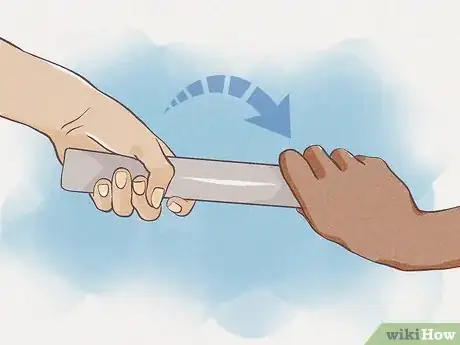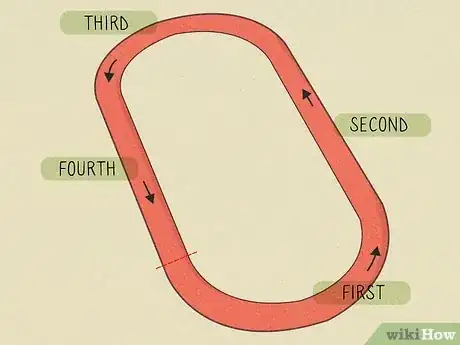This article was co-authored by Kai Ng. Kai Ng is a USATF and RRCA Certified Running Coach at Run Coach Kai. Kai has competed in over 55 races and over 15 marathons, and has trained with 16x USA and World record holder Patti Catalano Dillonso. He specializes in coaching runners of all levels and showing people that everyone can be a runner. Kai is committed to helping his clients reach their goals by showing them how to run with proper form and holding them accountable to train consistently.
There are 11 references cited in this article, which can be found at the bottom of the page.
wikiHow marks an article as reader-approved once it receives enough positive feedback. In this case, 80% of readers who voted found the article helpful, earning it our reader-approved status.
This article has been viewed 231,828 times.
The 4 x 100 relay, also called the 400-meter relay, is a sprint relay with four runners. Each runner runs approximately 100 meters before handing off a baton to the next runner. Before running the 4 x 100 relay, make sure that you and your teammates are experienced with sprint running and have practiced the baton exchange. This will help you to decide the order of your team, and ensure that you run your best race possible!
Steps
Choosing Runner Order
-
1Place your best starter first. The ideal first runner has an explosive takeoff and never gets disqualified for false starts. This position also requires fast running around the bend of the oval track.[1]
-
2Choose the second runner. The second runner should perfect their baton handling skills, as the second leg involves both receiving and passing the baton. This is a straight leg, so this is a good spot for a fast sprinter who is not really good at bends/curves.[2]
- This is a great spot for your fastest runner if they are much faster than the other three.[3] This is especially true if your fastest runner is also great at baton handoffs.
Advertisement -
3Pick a good bend runner for the third leg. In general, shorter runners are best around curves because they can accelerate faster than taller runners. This position also benefits from good baton handoff skills, and from the ability to compete under the pressure.[4]
- Although unorthodox, it could be smart to put your fastest runner here if they are also good on bends. A 200m specialist could do well on this leg.[5]
-
4End with an eager finisher. Many teams place their fastest runner last, perhaps so they can claim the glory! In fact, psychology may be more important than raw speed. This runner cannot get discouraged if they start the fourth leg behind the other teams. Choose a competitor who thrives under the end of race pressure.[6]
- If your two fastest runners are much faster than the other two, place them second and fourth. This allows you to maximize the distance they run.[7]
- At high levels of competition, choose a runner with advanced finishing techniques.[8] This includes "lifting," a running form with light ground contact and rapid knee lifts, and lunging, a carefully timed forward fall so the chest crosses the finish line sooner.[9]
-
5Adjust for smooth handoffs. All of your planning above will fall apart if an athlete can't perform consistent baton handoffs.[10] Consider these problems before you finalize the positions, and don't hesitate to rearrange if issues arise during practice:
- Size differences: If one runner is much taller than another, they may have trouble exchanging batons smoothly. Space them out so they don’t have to do a baton exchange.[11]
- If a pair of athletes do not practice well together for temperamental reasons, and the coach cannot solve this problem, consider rearranging so they don't have a handoff together.
- If one athlete is particularly poor at passing, consider placing them fourth. If an athlete is poor at receiving, consider putting them first.
Practicing the Relay
-
1Pick the baton exchange method. There are generally three methods of passing the baton: the upsweep, the down sweep, and the push pass. Try all three and see which your teammates prefer:[12]
- Upsweep: the outgoing runner runs with their hand behind them at hip level, palm down and thumb outstretched to form a V shape. The incoming runner inserts the baton upward between the thumb and fingers.
- Downsweep: similar to the upsweep, but the outgoing runner's hand is palm up and receives the baton in a downward motion.
- Push pass: the outgoing runner holds their arm high up behind them, with the palm sideways and the thumb pointing down. The incoming runner holds the baton vertically and pushes it into the palm.
-
2Stay on the correct side of the lane. When all goes well, the relay race is a smooth series of transfers, with no awkward jerks across the lane or switching from an athlete's left hand to the right. Practice this pattern until all four runners find it automatic:[13]
- First runner holds baton in right hand and runs on the inside edge of the lane.
- Second runner holds baton in left hand and stays on the outside.
- Third runner holds baton in right hand and stays on the inside.
- Fourth runner holds baton in left hand and receives on the outside.
-
3Decide where to relay the baton. Each baton handoff must occur inside a 20-meter changeover zone, between two yellow marks. The outgoing runner can start running up to 10 meters ahead of the changeover zone, but can only receive the baton within the zone. Use tactics as well as trial and error to find an exchange position that maximizes speed and smooth handoffs:
- Ideally, you can exchange the baton about 5 meters from the end of the zone.[14] This gives the outgoing runner more time to accelerate before receiving.[15]
- If the athletes have trouble with a quick handoff, or if they get nervous and slow down while waiting, exchange the baton just past the middle of the zone.[16]
- If one athlete is significantly faster than the others, they can receive earlier in the zone, carrying the baton for more than 100 meters.
-
4Keep running after you release the baton. A huge mistake in relay racing is to slow down before you release the baton. The best way to prevent this is to form the habit of "running through the zone." Keep up a full sprint until you're about halfway through the next leg.[17] If both runners have positioned themselves well (on opposite sides of the lane), the incoming runner should be able to run close behind without fearing a collision.
-
5Do speed drills. The 4x100 is all about speed. To prepare for the race, do drills such as hill sprints, suicides, and sprinting around comes to work on your agility and speed. Hill sprints are especially good for improving acceleration.[18]
-
6Practice the whole race. You don’t want the first time you run the race to be at the track meet or event. Run the event several times at least, at full speed. Have a coach or friend who is knowledgeable about running time each of your attempts. Also, have your friend or coach watch each runner and offer any critiques that they might have.[19]
Running the Race
-
1Position each runner. After doing warm-ups, make sure that every runner is in position. The first runner should be positioned on the starting blocks, holding the baton in his or her right hand.[20]
- The second runner should be positioned at the acceleration zone 10 meters before the first exchange zone. Each exchange zone is marked on most tracks by large, usually red, triangles. There should be a smaller triangle that marks the acceleration zone, which is where the second runner should be positioned.
- The third runner should be at the second acceleration zone before the exchange zone, and the fourth runner should be at the last acceleration zone.
-
2Start at the whistle. As soon as the whistle is blown, the first runner should start sprinting. Make sure that they lean in and accelerate through the bend in the track. They will run slightly more than 100 meters to the first exchange zone.
- Make sure that the runner runs on the inside of their lane, on the left-hand side, so that they can pass the baton to the next runner’s left hand.
-
3Do the first baton exchange. The first runner, with the baton in their right hand, will approach the exchange zone. The second runner should have their head turned, watching the incoming runner. When the incoming runner is about 7 meters from the outgoing runner, the outgoing runner should turn their head back and start running with their hand out. The first runner will hand the baton over to the second runner, who will take the baton in their left hand if the first runner hold it at his/her right hand.[21]
- Make sure that the baton exchange happens within the exchange zone because your team will be disqualified if it happens before or after the zone.
-
4Do the second baton exchange. The second runner will a straight leg of the track for another 100 meters. Make sure they are running on the right side of their lane. Meanwhile, the third runner will start running as soon as the second runner approaches the exchange zone. The second runner will pass the baton from his or her left hand into the right hand of the third runner.
- Again, be sure that the baton exchange happens within the exchange zone.
-
5Do the final exchange. The third runner will run around the bend on the track, the baton in their right hand. As they approach the last exchange zone, the fourth runner will start running with their hand out, and the incoming runner will put the baton in their left hand, making sure the exchange happens within the exchange zone.[22]
-
6Finish the race. The fourth runner, with the baton in their left hand, will run another 100 meters past the exchange zone to finish the race. Make sure that the fourth runner doesn’t slow down before the finish line, and instead sprints until they have crossed the line, with the baton still in their hand.[23]
Expert Q&A
-
QuestionHow should I prepare in advance?
 Kai NgKai Ng is a USATF and RRCA Certified Running Coach at Run Coach Kai. Kai has competed in over 55 races and over 15 marathons, and has trained with 16x USA and World record holder Patti Catalano Dillonso. He specializes in coaching runners of all levels and showing people that everyone can be a runner. Kai is committed to helping his clients reach their goals by showing them how to run with proper form and holding them accountable to train consistently.
Kai NgKai Ng is a USATF and RRCA Certified Running Coach at Run Coach Kai. Kai has competed in over 55 races and over 15 marathons, and has trained with 16x USA and World record holder Patti Catalano Dillonso. He specializes in coaching runners of all levels and showing people that everyone can be a runner. Kai is committed to helping his clients reach their goals by showing them how to run with proper form and holding them accountable to train consistently.
Certified Running Coach One of the most important things to work on is the transition. It doesn't matter how fast and efficient you are if you're not passing the baton successfully. It's important to work with your teammates on transition.
One of the most important things to work on is the transition. It doesn't matter how fast and efficient you are if you're not passing the baton successfully. It's important to work with your teammates on transition. -
QuestionIf I have two slow runners and two very fast runners, how should I position them and get a fast time?
 Community AnswerFast, slow, slow, fast. This pattern can usually encourage the slower members to keep the lead up.
Community AnswerFast, slow, slow, fast. This pattern can usually encourage the slower members to keep the lead up. -
QuestionHow can I increase my speed?
 Community AnswerRun on the balls of your feet instead of running flat-footed. Pump your arms and bring them up to nose/eye/ear height.
Community AnswerRun on the balls of your feet instead of running flat-footed. Pump your arms and bring them up to nose/eye/ear height.
Warnings
- Make sure you make the exchanges inside the exchange zones, or you'll get disqualified.⧼thumbs_response⧽
References
- ↑ http://www.athletics-training.com/articles/relay-running.html
- ↑ http://www.livingstonac.com/fs/1/info/coaching/4x100_Relay_Strategies.pdf
- ↑ https://www.brianmac.co.uk/sprints/relay.htm
- ↑ http://speedendurance.com/2010/11/28/exploiting-your-4x100-meter-relay-personnel/
- ↑ http://www.livingstonac.com/fs/1/info/coaching/4x100_Relay_Strategies.pdf
- ↑ http://www.athletics-training.com/articles/relay-running.html
- ↑ https://www.brianmac.co.uk/sprints/relay.htm
- ↑ http://www.livingstonac.com/fs/1/info/coaching/4x100_Relay_Strategies.pdf
- ↑ https://books.google.com/books?id=YiqowAKyNeQC
- ↑ Kai Ng. Certified Running Coach. Expert Interview. 12 February 2021.
- ↑ http://speedendurance.com/2010/11/28/exploiting-your-4x100-meter-relay-personnel/
- ↑ https://www.brianmac.co.uk/sprints/relay.htm
- ↑ http://speedendurance.com/2010/01/22/4x100-relay-baton-passing-upsweep-down-sweep-or-push-pass/
- ↑ https://www.brianmac.co.uk/sprints/relay.htm
- ↑ http://www.livingstonac.com/fs/1/info/coaching/4x100_Relay_Strategies.pdf
- ↑ http://www.coacheseducation.com/relay/Zone.php
- ↑ http://itccca.com/10836/2015/11/relay-runs-a-new-drill-for-4x100m-handoffs/
- ↑ http://www.nfl.com/news/story/0ap3000000392504/article/need-for-speed-three-exercises-to-make-you-faster
- ↑ http://www.coacheseducation.com/relay/Zone.php
- ↑ http://www.brianmac.co.uk/sprints/relay.htm
- ↑ http://www.brianmac.co.uk/sprints/relay.htm
- ↑ http://www.athletics-training.com/articles/relay-running.html
- ↑ http://www.athletics-training.com/articles/relay-running.html
- ↑ http://www.coacheseducation.com/relay/Zone.php
About This Article
To run a 4X100 relay, place your most explosive starter first. Pick a second runner who has perfect baton skills and is an excellent sprinter, while the third leg requires someone who is good at running the curves. The final runner needs to thrive under pressure and have a high level of competition. As you practice for the race, pick a baton exchange method that everyone’s comfortable with. Also, decide where within the changeover zone the runners will relay the baton. For tips on what side of the lane runners should use, keep reading!












































































